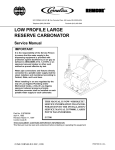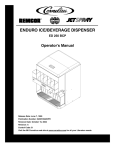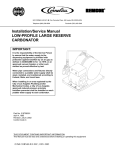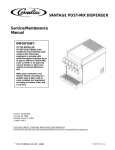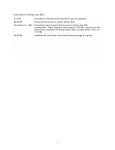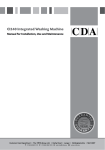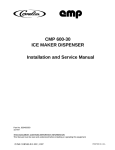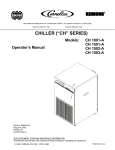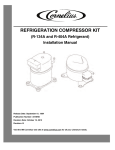Download Cornelius REMCOR 1550 Service manual
Transcript
IMI CORNELIUS INC g One Cornelius Place g Anoka, MN 55303-6234 Telephone (800) 238-3600 Facsimile (612) 422-3246 Service Manual C-1550XR UNIVERSAL PRE-MIX DISPENSER (R-404A REFRIGERANT) Part No. 309989004 January 7, 1986 Revised: January 27, 1999 Control Code A THIS DOCUMENT CONTAINS IMPORTANT INFORMATION This Manual must be read and understood before installing or operating this equipment Ó IMI CORNELIUS INC; 1986--99 PRINTED IN U.S.A TABLE OF CONTENTS Page SAFETY INFORMATION . . . . . . . . . . . . . . . . . . . . . . . . . . . . . . . . . . . . . . . . . . . . . . . . . . . . 1 RECOGNIZE SAFETY INFORMATION . . . . . . . . . . . . . . . . . . . . . . . . . . . . . . . . . . 1 UNDERSTAND SIGNAL WORDS . . . . . . . . . . . . . . . . . . . . . . . . . . . . . . . . . . . . . . . 1 FOLLOW SAFETY INSTRUCTIONS . . . . . . . . . . . . . . . . . . . . . . . . . . . . . . . . . . . . CO2 (CARBON DIOXIDE) WARNING . . . . . . . . . . . . . . . . . . . . . . . . . . . . . . . . . . . SHIPPING, STORING, OR RELOCATING UNIT . . . . . . . . . . . . . . . . . . . . . . . . . . GENERAL INFORMATION . . . . . . . . . . . . . . . . . . . . . . . . . . . . . . . . . . . . . . . . . . . . . . . . . . 1 1 1 3 TO THE USER OF THIS MANUAL . . . . . . . . . . . . . . . . . . . . . . . . . . . . . . . . . . . . . . . CLAIMS INSTRUCTIONS . . . . . . . . . . . . . . . . . . . . . . . . . . . . . . . . . . . . . . . . . . . . . . WARRANTY REFERENCE INFORMATION . . . . . . . . . . . . . . . . . . . . . . . . . . . . . . . 3 3 3 DESIGN DATA . . . . . . . . . . . . . . . . . . . . . . . . . . . . . . . . . . . . . . . . . . . . . . . . . . . . . . . . UNIT DESCRIPTION . . . . . . . . . . . . . . . . . . . . . . . . . . . . . . . . . . . . . . . . . . . . . . . . . . . THEORY OF OPERATION . . . . . . . . . . . . . . . . . . . . . . . . . . . . . . . . . . . . . . . . . . . . . . SERVICE AND MAINTENANCE . . . . . . . . . . . . . . . . . . . . . . . . . . . . . . . . . . . . . . . . . . . . . 3 4 4 5 PREPARING UNIT FOR SHIPPING, RELOCATING, OR STORING . . . . . . . . . . PERIODIC INSPECTION . . . . . . . . . . . . . . . . . . . . . . . . . . . . . . . . . . . . . . . . . . . . . . . ADJUSTMENTS . . . . . . . . . . . . . . . . . . . . . . . . . . . . . . . . . . . . . . . . . . . . . . . . . . . . . . . 5 5 5 ADJUSTING PRODUCT TANK CO2 REGULATORS . . . . . . . . . . . . . . . . . . . . . . 5 ADJUSTING DISPENSED PRODUCT FLOW RATE . . . . . . . . . . . . . . . . . . . . . . 6 REPLENISHING CO2 SUPPLY . . . . . . . . . . . . . . . . . . . . . . . . . . . . . . . . . . . . . . . . . . 6 REPLENISHING PRODUCT SUPPLY . . . . . . . . . . . . . . . . . . . . . . . . . . . . . . . . . . . . 6 PRODUCT FLAVOR CHANGE . . . . . . . . . . . . . . . . . . . . . . . . . . . . . . . . . . . . . . . . . . 10 CLEANING CONDENSER COIL . . . . . . . . . . . . . . . . . . . . . . . . . . . . . . . . . . . . . . . . . 10 CHECKING ICE WATER BATH . . . . . . . . . . . . . . . . . . . . . . . . . . . . . . . . . . . . . . . . . . 10 CLEANING WATER TANK . . . . . . . . . . . . . . . . . . . . . . . . . . . . . . . . . . . . . . . . . . . . . . 10 CLEANING AND SANITIZING . . . . . . . . . . . . . . . . . . . . . . . . . . . . . . . . . . . . . . . . . . . 11 DAILY CLEANING OF UNIT . . . . . . . . . . . . . . . . . . . . . . . . . . . . . . . . . . . . . . . . . . . 11 SANITIZING PRE-MIX SYSTEMS . . . . . . . . . . . . . . . . . . . . . . . . . . . . . . . . . . . . . . 12 CLEANING CO2 GAS CHECK VALVES . . . . . . . . . . . . . . . . . . . . . . . . . . . . . . . . . . 13 TROUBLESHOOTING . . . . . . . . . . . . . . . . . . . . . . . . . . . . . . . . . . . . . . . . . . . . . . . . . . . . . . 15 TROUBLESHOOTING PRODUCT SYSTEM . . . . . . . . . . . . . . . . . . . . . . . . . . . . . . 15 NO PRODUCT DISPENSED. . . . . . . . . . . . . . . . . . . . . . . . . . . . . . . . . . . . . . . . . . . 15 DISPENSED PRODUCT COMES OUT OF DISPENSING VALVE CLEAR BUT FOAMS IN CUP OR GLASS . . . . . . . . . . . . . . . . . . . . . . . . . . . . . . . . . . . . . . . 15 DISPENSED PRODUCT FOAMS AS IT LEAVES DISPENSING VALVE. . . . . . 15 TROUBLESHOOTING REFRIGERATION SYSTEM . . . . . . . . . . . . . . . . . . . . . . . . 16 COMPRESSOR DOES NOT OPERATE. . . . . . . . . . . . . . . . . . . . . . . . . . . . . . . . . 16 COMPRESSOR WILL NOT STOP AFTER SUFFICIENT ICE BANK IS FORMED.. . . . . . . . . . . . . . . . . . . . . . . . . . . . . . . . . . . . . . . . . . . . . . . . . . . . . . . . . 16 COMPRESSOR OPERATES CONTINUOUSLY BUT DOES NOT FORM SUFFICIENT ICE BANK. . . . . . . . . . . . . . . . . . . . . . . . . . . . . . . . . . . . . . . . . . . . . . . 16 CONDENSER FAN MOTOR NOT OPERATING. . . . . . . . . . . . . . . . . . . . . . . . . . . 17 AGITATOR MOTOR NOT OPERATING. . . . . . . . . . . . . . . . . . . . . . . . . . . . . . . . . . 17 WARRANTY . . . . . . . . . . . . . . . . . . . . . . . . . . . . . . . . . . . . . . . . . . . . . . . . . . . . . . . . . . . . . . 18 i 309989004 TABLE OF CONTENTS (cont’d) Page LIST OF FIGURES FIGURE 1. UNIVERSAL C-1550XR (FOUR-FLAVOR UNIT SHOWN) . . . . . . . . . 4 FIGURE 2. DISPENSER COMPONENTS (FOUR-FLAVOR UNIT SHOWN) . . . FIGURE 3. PARTS IDENTIFICATION (FOUR-FLAVOR UNIT SHOWN) . . . . . . . FIGURE 4. FLOW DIAGRAM (FOUR-FLAVOR UNIT SHOWN) . . . . . . . . . . . . . . FIGURE 5. CO2 GAS CHECK VALVE . . . . . . . . . . . . . . . . . . . . . . . . . . . . . . . . . . . . FIGURE 6. WIRING DIAGRAM . . . . . . . . . . . . . . . . . . . . . . . . . . . . . . . . . . . . . . . . . . 7 8 9 13 14 LIST OF TABLES TABLE 1. DESIGN DATA . . . . . . . . . . . . . . . . . . . . . . . . . . . . . . . . . . . . . . . . . . . . . . . 309989004 ii 3 SAFETY INFORMATION Recognize Safety Information This is the safety-alert symbol. When you see this symbol on our machine or in this manual, be alert to the potentially of personal injury. Follow recommended precautions and safe operating practices. Understand Signal Words A signal word - DANGER, WARNING, OR CAUTION is used with the safety-alert symbol. DANGER identifies the most serious hazards. Safety signs with signal word DANGER or WARNING are typically near specific hazards. General precautions are listed on CAUTION safety signs. CAUTION also calls attention to safety messages in this manual. DANGER WARNING CAUTION Follow Safety Instructions Carefully read all safety messages in this manual and on your machine safety signs. Keep safety signs in good condition. Replace missing or damaged safety signs. Learn how to operate the machine and how to use the controls properly. Do not let anyone operate the machine without instructions. Keep your machine in proper working condition. Unauthorized modifications to the machine may impair function and/or safety and affect the machine life. CO2 (Carbon Dioxide) Warning CO2 Displaces Oxygen. Strict Attention must be observed in the prevention of CO2 (carbon dioxide) gas leaks in the entire CO2 and soft drink system. If a CO2 gas leak is suspected, particularly in a small area, immediately ventilate the contaminated area before attempting to repair the leak. Personnel exposed to high concentration of CO2 gas will experience tremors which are followed rapidly by loss of consciousness and suffocation. Shipping, Storing, Or Relocating Unit CAUTION: Before shipping, relocating, or storing this Unit, the product coils must be flushed with potable water, all water must be purged from the product coils, ice bank must be melted, and water must be drained from the water tank. A freezing ambient environment will cause residual water remaining inside the Unit to freeze resulting in damage to the Unit internal components. 1 309989004 THIS PAGE LEFT BLANK INTENTIONALLY 309989004 2 GENERAL INFORMATION TO THE USER OF THIS MANUAL This Manual is a guide for servicing and maintaining this equipment. Refer to Table of Contents for page location of detailed information pertaining to questions that may arise. This Unit must be installed and serviced by a qualified Service Person. This Unit contains no User serviceable parts. CLAIMS INSTRUCTIONS Claims: In the event of shortage, notify the carrier as well as IMI Cornelius immediately. In the event of damage, notify the carrier. IMI Cornelius is not responsible for damage occurring in transit, but will gladly render assistance necessary to pursue your claim. Merchandise must be inspected for concealed damage within 15 days of receipt. WARRANTY REFERENCE INFORMATION Warranty Registration Date (to be filled out by customer) Unit Part Number: Serial Number: Install Date: Local Authorized Service Center: DESIGN DATA Table 1. Design Data Unit Part Numbers: Universal C-1550XR Four-Flavor Universal C-1550XR Four-Flavor Universal C-1550XR Five-Flavor Universal C-1550XR Five-Flavor (230 VAC, 50 Hz) Universal C-1550XR Five-Flavor (115 VAC, 60 Hz) Universal C-1550XR Five-Flavor (230 VAC, 50 Hz) 2849749020 2849749200 2849759200 4949759020 2849759020 4949759200 Overall Dimensions: Height Width Depth (with drip tray) 42-1/2 inches 21-3/4-inches 31-1/2 inches Weights: Shipping (1 Carton) Dry Weight With Water Tank Full of Water Ice Bank Weight 189 pounds 170 pounds 403 pounds 100 pounds Capacities: Unit Water Bath (no ice bank) approx. 28 gallons 3 309989004 Table 1. Design Data (cont’d) Dispensing Rate: 12-oz. drinks 8/minute 724 (see NOTE) NOTE: *Number of 12-oz. drinks that can be dispensed at 40°F or below with 75°F product inlet temperature and 75°F ambient. Refrigerant Requirement See Unit Nameplate Ambient Operating Temperature 40°F to 100°F Electrical Requirements: See Unit Nameplate UNIT DESCRIPTION The Unit (see Figure 1) is equipped with manually operated self-closing dispensing valves. The Unit is equipped with a handle and wheels which makes it a mobile Unit. The refrigeration system is equipped with a 3/4 H.P. compressor that is easily accessible for service and maintenance. THEORY OF OPERATION (see Figure 4) A CO2 cylinder delivers carbon dioxide (CO2) gas through adjustable CO2 regulators to the product tanks. When dispensing valves are opened, CO2 pressure exerted upon the product tanks pushes product from the tanks, through the Unit cooling coils, and on to the dispensing valves resulting in cold dispensed drinks. When Unit power cord has been plugged into the electrical outlet and power switch (115 VAC, 60-Hz Units only) on back of the Unit has been positioned to ‘‘ON’’(up) position, the compressor, condenser fan motor, and agitator motor will start and begin forming an ice bank. When a full ice bank has been formed, the compressor and condenser fan motor will stop but the agitator motor will continue to operate, circulating ice water bath in water tank. The water tank ice bank sensing bulb will cycle the compressor and the condenser fan motor on and off as required to maintain a full ice bank. FIGURE 1. UNIVERSAL C-1550XR (FOUR-FLAVOR UNIT SHOWN) 309989004 4 SERVICE AND MAINTENANCE This section describes the service and maintenance procedures to be performed on the Unit. IMPORTANT: Only qualified Personnel should service the Unit internal components or electrical wiring. WARNING: Disconnect electrical power from the Unit to prevent personnel injury before attempting any internal maintenance. Only qualified personnel should service the internal components or electrical wiring. CAUTION: This Unit is intended for indoor installation only. Do not install this Unit in an outdoor environment which would expose it to the outside elements. IMPORTANT: For the most efficient operation of the Unit, the ambient operating temperature for the Unit should not exceed 90°F. Satisfactory temperatures may be obtained using blowers, air conditioning, etc. Check your local codes. PREPARING UNIT FOR SHIPPING, RELOCATING, OR STORING CAUTION: Before shipping, relocating, or storing the Unit, the product cooling coils must be sanitized, all sanitizing solution must be purged from the product coils, the ice bank must be melted, and all water must be drained from the water tank. A freezing ambient environment will cause residual water remaining inside the Unit to freeze resulting in damage to internal components of the Unit. PERIODIC INSPECTION 1. Check Unit condenser coil (see Figure 3) for accumulation of dust, lint, or grease and if necessary, clean the coil as instructed. Restriction of air flow through the condenser coil will decrease cooling efficiency of the Unit. 2. Check area in front, back, sides, and above the Unit for obstructions. These areas must be kept clear at all times. Listed below are the minimum clearances that must be maintained. A. Clearance above the Unit ---------------------------------------------------------- 12 inches to nearest obstruction. B. Clearance back of Unit -------------------------------------------------------------- 12 inches to nearest obstruction. C. Clearance on sides of Unit ----------------------------------------------------------12 inches to nearest obstruction. D. Clearance on front of Unit ---------------------------------------------------------- Open 3. Check dispensing valves for dripping that indicates leaking and repair as necessary. ADJUSTMENTS ADJUSTING PRODUCT TANK CO2 REGULATORS (see Figure 4) NOTE: To adjust CO2 regulator to provide a lower pressure, loosen adjusting screw lock nut, then turn screw to the left (counterclockwise) until pressure gage reads 5-psi lower than new setting will be. Turn adjusting screw to the right (clockwise) until gage registers new setting. Then tighten lock nut. 5 309989004 Set product tank CO2 regulators, using Cornelius PRE-MIX COMPUTER slide rule or bottling room chart. Enter equilibrium pressure for highest temperature encountered between product tank storage area and cooling unit plus 5 psig operating pressure for lines 10 feet in length or less and no vertical lift. Add one pound for every 10 feet over initial 10 feet of product tank to cooling unit line length and one pound for every 2 feet of vertical lift. Add one pound for every product tank on line over three tanks. MAXIMUM UNIT INLET PRESSURE MUST NOT EXCEED 100 psig. Loosen lock nut on CO2 regulator adjusting screw, then turn adjusting screw to the right (clockwise) until gage registers desired pressure. Tighten adjusting screw lock nut. ADJUSTING DISPENSED PRODUCT FLOW RATE (see Figure 2) Rotate dispensing valve Compensator Adjusting Screw to the left (counterclockwise) for higher product flow rate or to the right (clockwise) for lower product flow rate. REPLENISHING CO2 SUPPLY NOTE: When indicator on CO2 cylinder regulator assembly 1800 psi gage is in shaded (‘‘change CO2 cylinder’’) portion of dial, CO2 cylinder is almost empty and should be replaced. CAUTION: Wear protective eyewear to avoid injury from gas-driven particles. WARNING: CO2 displaces oxygen. Strict attention must be observed in the prevention of CO2 (carbon dioxide) gas leaks in the entire CO2 and soft drink system. If a CO2 gas leak is suspected, particularly in a small area, immediately ventilate the contaminated area before attempting to repair the leak. Personnel exposed to high concentration of CO2 gas will experience tremors which are followed rapidly by loss of consciousness and suffocation. 1. Fully close (clockwise) CO2 cylinder valve. 2. Slowly loosen CO2 regulator assembly coupling nut allowing CO2 pressure to escape, then remove regulator assembly from empty CO2 cylinder. 3. Unfasten safety chain and remove empty CO2 cylinder. WARNING: To avoid personal injury and/or property damage, always secure CO2 cylinder in an upright position with safety chain to prevent it from falling over. Should the shutoff valve become accidentally broken off, CO2 cylinder can cause serious personal injury. 4. Position CO2 cylinder and secure with safety chain. 5. Make sure gasket is in place inside CO2 regulator coupling nut, then install regulator on CO2 cylinder. 6. Open (counterclockwise) CO2 cylinder valve slightly to allow lines to slowly fill with gas, then open valve fully to back-seat valve. (Back-seating valve prevents leakage around valve shaft). 7. Check CO2 connections for leaks. REPLENISHING PRODUCT SUPPLY 1. Remove inlet (CO2) disconnect (grey) and outlet disconnect (black) from empty product tank, then remove tank. 2. Place full product tank in position, then connect inlet (CO2) disconnect (grey) and outlet disconnect (black) to tank. 309989004 6 UNIT PRODUCT INLET LINES POWER CORD UNIT POWERSWITCH (115 VAC, 60 HZ UNIT ONLY) DRIP TRAY DRAIN HOSE PLUG WATER TANK OVERFLOW TUBE WATER TANK DRAIN HOSE TOP COVER DISPENSING VALVE (4) COVER RETAINING SCREW (4) COMPENSATOR ADJUSTING SCREW CUP REST VALVE TRIM PANEL DRIP TRAY DRAIN HOSE RETAINING SCREW (4) ACCESS GRILLE (4) DRIP TRAY AIR INTAKE FIGURE 2. DISPENSER COMPONENTS (FOUR-FLAVOR UNIT SHOWN) 7 UNIT PRODUCT INLET LINES ELECTRICAL CONTROL BOX POWER CORD TERMINAL BLOCK RETAINING SCREW CONDENSER COIL CONDENSER FAN MOTOR ACCESS GRILLE UNIT POWERSWITCH (115 VAC, 60 HZ UNIT ONLY) COMPRESSOR FIGURE 3. PARTS IDENTIFICATION (FOUR-FLAVOR UNIT SHOWN) 309989004 8 9 309989-000 GAS CHECK VALVE (4) CO2 CYLINDER PRODUCT TANKS PRIMARY CO2 REGULATOR CO2 PRODUCT LINE LEDGEND PRODUCT TANK (4) 4 3 2 1 PRODUCT COOLING COIL (4) FIGURE 4. FLOW DIAGRAM (FOUR-FLAVOR UNIT SHOWN) CO2 MANIFOLD CO2 CYLINDER PRESSURE GAGE DISPENSER DISPENSING VALVE (4) 4 3 2 1 PRODUCT FLAVOR CHANGE Sanitize applicable system as instructed, then install full tank of new flavor product. CLEANING CONDENSER COIL (see Figure 3) NOTE: Air circulation through the condenser coil, required to cool the coil, is drawn in through grille on Unit front panel and is exhausted out through grilles on sides and back of the Unit. Restricting air flow through the condenser coil will decrease cooling efficiency of the Unit. Area in front, sides, and back of the Unit must be kept free of obstructions at all times which would prevent air flow in and out of the Unit. An excessive accumulation of dust, lint, and grease on the condenser coil will restrict air flow through the coil which will decrease cooling efficiency of the Unit. The Unit condenser coil should be periodically cleaned by performing the following: 1. Unplug Unit power cord from electrical outlet. 2. Remove four screws securing air intake grille on the Unit front panel, then remove the grille. 3. Vacuum or use a soft brush to clean the condenser coil. If available, use low-pressure compressed air. 4. Install air intake grille on the Unit and secure with four screws. 5. Plug Unit power cord into electrical outlet. CHECKING ICE WATER BATH A “gurgle’heard from the Unit, indicates water level in the water tank is low and more water should be added for maximum product cooling. Before adding more water to the water tank, the ice water bath and the ice bank should be checked for cleanliness and the water tank components checked for excessive mineral deposit build-up. 1. Unplug Unit power cord from electrical outlet. 2. Remove four screws securing the Unit top cover, then remove cover. 3. Check condition of the ice water bath and the ice bank. The ice water bath should be clear and the ice bank should be free of foreign particles. 4. Check agitator motor shaft and ice bank sensing bulb for excessive mineral deposit build-up. 5. If cleaning of water tank is necessary, refer to CLEANING WATER TANK in this section for cleaning procedure. 6. Make sure end of water tank overflow tube is placed in a waste container. Fill water tank with clean wateruntil water starts flowing from overflow tube into the waste container. USE A LOW-MINERAL-CONTENT WATER WHERE A LOCAL WATER PROBLEM EXIST. 7. Install Unit top cover and secure with four screws. 8. Plug Unit power cord into electrical outlet. After water has stopped dripping from the water tank overflow tube, remove tube from the waste container and place back inside the Unit. CLEANING WATER TANK NOTE: The ice water bath should be changed as often as necessary to keep the water tank clean. A convenient time to perform this operation is at the time the Unit is being sanitized. To save time, water can be drained from the water tank while the Unit is being sanitized. 309989004 10 1. Unplug Unit power cord from electrical outlet. 2. Remove screws securing the Unit top cover, then remove cover. 3. Remove four screws securing either the side or the back access grille, then remove the grille. 4. Route water tank drain hose out hole in back of the Unit to a waste container or to a drain. 5. Remove plug from end of the drain hose and allow water to drain from the water tank. NOTE: If ice bank is clear and contains no foreign particles, it does not have to be melted down. Skip steps 6 and 7 and proceed with step 8 . 6. If ice bank is dirty, allow it to melt. Hot water may be used to speed up melting. CAUTION: Never use an ice pick or other instrument to remove ice from the evaporator coil. Such practice can result in a punctured refrigerant circuit or damage to the water tank. 7. Wash inside of the water tank with a mild soap solution. 8. Using a fiber brush, carefully clean mineral deposit build-up from the agitator motor shaft and the ice bank sensing bulb. 9. Rinse all parts and flush water tank with clean water. 10. Install plug in end of the water tank drain hose, then place drain hose back inside the Unit. 11. Place end of the Unit water tank overflow tube in a waste container. 12. Fill water tank with clean water until water starts flowing from the overflow tube into the waste container. USE A LOW-MINERAL-CONTENT WATER WHERE A LOCAL WATER PROBLEM EXIST. 13. Install Unit top cover and secure with four screws. 14. Plug Unit power cord into electrical outlet. Make sure compressor, condenser fan motor, and agitator motor are operating. 15. After water has stopped dripping from the water tank overflow tube, remove tube from the waste container, then place tube back inside the Unit. 16. Install access grille on the Unit and secure with screws. CLEANING AND SANITIZING DAILY CLEANING OF UNIT NOTE: A drip tray that does not have a drain hose routed to a waste container or a permanent drain must be removed from the Unit and be thoroughly cleaned. A drip tray that has a drip tray drain hose routed to a waste container or a permanent drain may be cleaned in place on the Unit as follows. 17. Remove cup rest from the drip tray. 18. Wash drip tray in place on the Unit, then rinse drip tray with hot water allowing water to drain out through the drain hose. 19. Wash cup rest, then rinse the cup rest with clean water. Install cup rest in drip tray. 20. Clean all external surfaces of the Unit with a sponge. Rinse out the sponge with clean water, then wring excess water out of the sponge and wipe off all external surfaces of the Unit. Wipe Unit dry with a clean soft cloth. DO NOT USE ABRASIVE-TYPE CLEANERS. 11 309989004 SANITIZING PRE-MIX SYSTEMS IMPORTANT: Only qualified Service Personnel should perform sanitizing procedure on the pre-mix product systems. The pre-mix product systems should be sanitized every 90-days using a non-scented household liquid bleach such as Hi-Lex or Chlorox containing a 5.25% sodium hypochlorite concentration. Proceed as follows to sanitize the pre-mix product systems. 1. Disconnect product tanks from the product systems. 2. Rinse product tanks quick disconnects with warm potable water. 3. Using a clean empty product tank, prepare a full tank of non-scented liquid dishwasher detergent solution by using 70°F (21°C) to 100°F (38°C) potable water and 0.5 oz. (15 ml) of liquid dishwasher detergent (such as Joy, Ivory, etc.) to one gallon of potable water. Shake tank containing detergent solution to thoroughly mix the solution. 4. Connect tank containing detergent solution into one of the product systems. 5. Place waste container under the applicable dispensing valve. 6. Activate the dispensing valve to permit detergent solution to purge product out of the line, coil, and the dispensing valve. Continue to dispense until only detergent solution is dispensed from the dispensing valve. 7. Connect tank containing detergent solution into remaining product systems and flush product out of systems as instructed in steps 5 and 6 preceding. 8. Using a clean product tank, prepare sanitizing solution using 70°F (21°C) to 100°F (38°C) potable water and 0.5 oz. (15 ml) of household liquid bleach such as non-scented Hi-Lex or Chlorox that contains a 5.25 % sodium hypochlorite concentration to one gallon of potable water. This mixture must not exceed 200 PPM of chlorine. Shake tank containing sanitizing solution to thoroughly mix the solution. 9. Connect tank containing sanitizing solution into one of the product systems. 10. Place waste container under the applicable dispensing valve. 11. Activate the dispensing valve for one minute to purge detergent solution from and install sanitizing solution in the product system. 12. Continue activating the dispensing valve in cycles (“ON”for 15--seconds, “OFF”, then “ON”for 15-seconds). Repeat “ON”and “OFF”cycles for 15 cycles. 13. Repeat steps 9 through 11 preceding to purge detergent solution from the remaining product systems. 14. Allow sanitizing solution to remain in the product system for not less than 10-minutes or for no more than 15-minutes. 15. Connect product tank containing potable water into the product system to be flushed. WARNING: Flush sanitizing solution from the system(s) as instructed. Residual sanitizing solution left in the product system(s) could create a health hazard. 16. Place waste container under applicable dispensing valve. 17. Activate the dispensing valve for one minute to purge all sanitizing solution out of the product system. 18. Continue activating the dispensing valve in cycles (“ON”for 15--seconds, “OFF”, then “ON”for 15-seconds). Repeat “ON”and “OFF”cycles for 15 cycles. 19. Repeat steps 15 through 18 preceding to purge sanitizing solution from the remaining product systems. 309989004 12 20. Remove product tank containing flush water from the product system, then connect a clean empty product tank into the system. 21. Place waste container under applicable dispensing valve. 22. Activate the dispensing valve to purge all water from the product system. 23. Repeat steps 20 and 22 preceding to purge all water from the remaining product systems. 24. Dispose of waste sanitizing solution in a sanitary sewer, not in a storm drain, then thoroughly rinse the inside and the outside of the container that was used for sanitizing solution to remove all sanitizing solution residue. CLEANING CO2 GAS CHECK VALVES (see Figures 4 and 5) The primary CO2 regulator assembly CO2 gas check valves must be inspected and serviced at least once a year under normal conditions and after any servicing or disruption of the CO2 system. ALWAYS REPLACE QUAD RING SEAL EACH TIME GAS CHECK VALVES ARE SERVICED. QUAD RING 183294000 BALL 183296000 SPRING 183297000 RETAINER 183298000 BODY 183295100 *Quad ring seal must be replaced each time check valve is serviced. FIGURE 5. CO2 GAS CHECK VALVE 13 309989004 FIGURE 6. WIRING DIAGRAM 309989004 14 TROUBLESHOOTING IMPORTANT: Only qualified personnel should service internal components or electrical wiring. WARNING: If repairs are to be made to a product system, remove quick disconnects from the applicable product tank, then relieve the system pressure before proceeding. If repairs are to be made to the CO2 system, stop dispensing, shut off the CO2 supply, then relieve the system pressure before proceeding. If repairs are to be made to the refrigeration system, make sure electrical power is disconnected from the Unit. TROUBLESHOOTING PRODUCT SYSTEM Trouble NO PRODUCT DISPENSED. DISPENSED PRODUCT COMES OUT OF DISPENSING VALVE CLEAR BUT FOAMS IN CUP OR GLASS Probable Cause Remedy A. Product tank quick disconnects not attached properly. A. Attach quick disconnects securely. B. No product supply (product tank empty). B. Replenish product supply as instructed. C. No CO2 supply. C. Replenish CO2 supply as instructed. A. Oil film or soap scum in cup or glass. A. Use clean cups and glasses. B. Ice used for finished drink is sub-cooled. B. Do not use ice directly from freezer. Allow ice to become ‘‘wet’’before using. (Refer to following NOTE) NOTE: Crushed ice also causes dispensing problems. When dispensed drink hits sharp edges of ice, carbonation is released from dispensed drink. DISPENSED PRODUCT FOAMS AS IT LEAVES DISPENSING VALVE. A. Recovery rate of unit exceeded (ice bank depleted). A. Allow ice bank to recover. B. Product tanks CO2 regulator adjusted too high. B. Adjust product tanks CO2 regulator to proper equilibrium pressure as instructed, then replace product supply. C. Dispensing valve restricted or dirty. C. Sanitize product system as instructed. D. Tapered nylon washer inside tube swivel nut connection distorted from being overtightened restricting product flow. D. Replace nylon washer. Make sure it is properly seated. E. Oil, water, or dirt in CO2 supply. E. Remove contaminated CO2. Clean CO2 system (lines, regulators, etc.). Install clean CO2 supply. 15 309989004 Trouble Probable Cause Remedy TROUBLESHOOTING REFRIGERATION SYSTEM COMPRESSOR DOES NOT OPERATE. COMPRESSOR WILL NOT STOP AFTER SUFFICIENT ICE BANK IS FORMED. (NOTE--ICE BANK SHOULD JUST COVER CONTROL BULB). COMPRESSOR OPERATES CONTINUOUSLY BUT DOES NOT FORM SUFFICIENT ICE BANK. A. Ice bank sufficient. A. Refrigeration not called for. B. Unit power cord unplugged or Unit power switch in ‘‘OFF’’ (down) position. B. Plug in power cord or place power switch in ‘‘ON’’(up) position. C. No power source (blown fuse or tripped circuit breaker). C. Replace fuse or reset circuit breaker. (Note: Fuse or circuit breaker are not part of Unit.) D. Low voltage at compressor terminals. D. Voltage must be at least 103 volts (115 VAC Unit) or 208 (230 VAC Unit) at compressor terminals when compressor is trying to start. E. Loose, disconnected, or broken wiring. E. Tighten connections or replace broken wiring. F. Overload protector cut out; over--heated compressor. Condenser fan motor not operating as required. F. Compressor will cool enough to restart. Do not overdraw cooling capacity of Unit. Refer to ‘‘CONDENSER FAN MOTOR NOT OPERATING’’in this section. G. Inoperative overload protector or start relay. G. Replace inoperative part. H. Inoperative ice bank control. H. Replace ice bank control. I. Inoperative compressor. I. Replace compressor. A. Ice bank control cap tube kinked or broken. A. Replace ice bank control. B. Ice bank control stuck in closed position. B. Replace ice bank control. A. Cooling capacity is exceeded by over--drawing. A. Reduce amount of drinks drawn per given time. B. Unit located in excessively hot area or air circulation through condenser coil is restricted. B. Relocate Unit or determine and correct condenser coil restriction. C. Refrigeration system leak. C. Repair refrigeration system. NOTE: Ice bank freezes from bottom of evaporator upward. A refrigerant leak or insufficient charge might show an ice bank at bottom and not at top of evaporator. NOTE: If overload protector cuts out compressor, condenser fan motor will continue to operate; otherwise; troubleshooting condenser fan motor problems is same as for ‘‘COMPRESSOR DOES NOT OPERATE’’paragraph plus the following: 309989004 16 Trouble Probable Cause Remedy CONDENSER FAN MOTOR NOT OPERATING. A. Jumper cord loose or disconnected from motor or terminal block. Broken wire in cord. A. Tighten connections or replace cord. CONDENSER FAN MOTOR NOT OPERATING. (cont’d) B. Fan blade obstructed. B. Remove obstructions. C. Inoperative condenser fan motor. C. Replace condenser fan motor. A. Unit power cord or agitator motor power cord disconnected or Unit power switch in ‘‘OFF’’position. A. Plug in power cords or place Unit power switch in ‘‘ON’’position. B. No power source (blown fuse or tripped circuit breaker). B. Replace fuse or reset circuit breaker. (Note: Fuse or circuit breaker are not part of Unit.) C. Agitator motor propeller obstructed. C. Remove obstruction. D. Low voltage. D. Voltage must be at least 103 volts (115 VAC Unit) or 208 (230 VAC Unit) at compressor terminals when compressor is trying to start. E. Loose, disconnected, or broken wiring. E. Tighten connections or replace broken wiring. F. Inoperative agitator motor. F. Replace agitator motor as instructed. AGITATOR MOTOR NOT OPERATING. 17 309989004 WARRANTY IMI Cornelius Inc. warrants that all equipment and parts are free from defects in material and workmanship under normal use and service. For a copy of the warranty applicable to your Cornelius, Remcor or Wilshire product, in your country, please write, fax or telephone the IMI Cornelius office nearest you. Please provide the equipment model number, serial number and the date of purchase. IMI Cornelius Offices AUSTRALIA D P.O. 210, D RIVERWOOD, D NSW 2210, AUSTRALIA D (61) 2 533 3122 D FAX (61) 2 534 2166 AUSTRIA D AM LANGEN FELDE 32 D A-1222 D VIENNA, AUSTRIA D (43) 1 233 520 D FAX (43) 1-2335-2930 BELGIUM D BOSKAPELLEI 122 D B-2930 BRAASCHAAT, BELGIUM D (32) 3 664 0552 D FAX (32) 3 665 2307 BRAZIL D RUA ITAOCARA 97 D TOMAS COELHO D RIO DE JANEIRO, BRAZIL D (55) 21 591 7150 D FAX (55) 21 593 1829 ENGLAND D TYTHING ROAD ALCESTER D WARWICKSHIRE, B49 6 EU, ENGLAND D (44) 789 763 101 D FAX (44) 789 763 644 FRANCE D 71 ROUTE DE ST. DENIS D F-95170 DEUIL LA BARRE D PARIS, FRANCE D (33) 1 34 28 6200 D FAX (33) 1 34 28 6201 GERMANY D CARL LEVERKUS STRASSE 15 D D-4018 LANGENFELD, GERMANY D (49) 2173 7930 D FAX (49) 2173 77 438 GREECE D 488 MESSOGION AVENUE D AGIA PARASKEVI D 153 42 D ATHENS, GREECE D (30) 1 600 1073 D FAX (30) 1 601 2491 HONG KONG D 1104 TAIKOTSUI CENTRE D 11-15 KOK CHEUNG ST D TAIKOKTSUE, HONG KONG D (852) 789 9882 D FAX (852) 391 6222 ITALY D VIA PELLIZZARI 11 D 1-20059 D VIMARCATE, ITALY D (39) 39 608 0817 D FAX (39) 39 608 0814 NEW ZEALAND D 20 LANSFORD CRES. D P.O. BOX 19-044 AVONDALE D AUCKLAND 7, NEW ZEALAND D (64) 9 8200 357 D FAX (64) 9 8200 361 SINGAPORE D 16 TUAS STREET D SINGAPORE 2263 D (65) 862 5542 D FAX (65) 862 5604 SPAIN D POLIGONO INDUSTRAIL D RIERA DEL FONOLLAR D E-08830 SANT BOI DE LLOBREGAT D BARCELONA, SPAIN D (34) 3 640 2839 D FAX (34) 3 654 3379 USA D ONE CORNELIUS PLACE D ANOKA, MINNESOTA D (612) 421-6120 D FAX (612) 422-3255 LD004 4/21/98 309989004 18 THIS PAGE LEFT BLANK INTENTIONALLY 19 309989004 IMI CORNELIUS INC. CORPORATE HEADQUARTERS: One Cornelius Place Anoka, Minnesota 55303-6234 (612) 421-6120 (800) 238-3600

























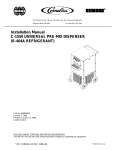
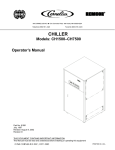
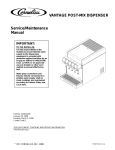
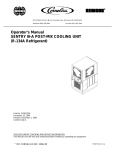
![Service Manual VA13 Carbonator [ 002818 ]](http://vs1.manualzilla.com/store/data/006013608_1-0f8f87056a0ab013b1dd01dac3912d47-150x150.png)
